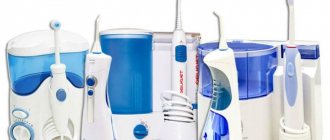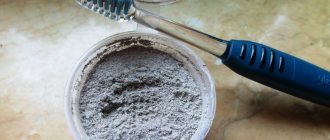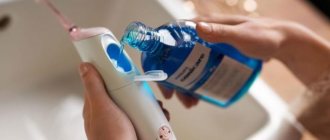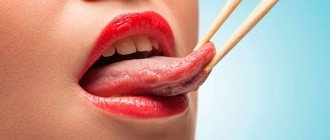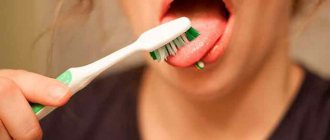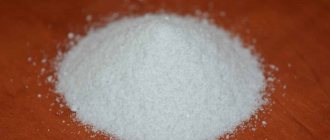Soda, also known as potassium bicarbonate, has many positive properties necessary for oral care. It affects teeth and gums in the following way: removes plaque, reduces inflammation, disinfects the oral cavity, and prevents caries from developing.
When a person regularly uses baking soda as an additive to water when rinsing or cleanses the oral cavity with powder, the result is healthy teeth for a long time. Using baking soda powder, you can even independently remove tartar that has become visible to the naked eye (initially the stone is not visible, it is examined by the dentist under a special lamp and is not yet black in color).
Treatment of gums with salt
Causes of gum inflammation
Why salt helps
How to properly rinse your mouth with saline solution
Salt gum massage
Other methods for treating gums at home
Bleeding gums, increased sensitivity and bad breath indicate that your gums are not healthy. Why do they become inflamed? Is it necessary to see a doctor or can they be strengthened at home? How to use salt to relieve inflammation? Read more in the article.
When is it better to avoid rinsing - contraindications
If the recommended dosages are observed, the medicinal solution is completely harmless and safe. But in some pathological conditions and individual intolerance to its components, the use of the product is strictly contraindicated.
So, it is better not to add soda to the composition if a small child is going to rinse the mouth. Under the age of 3-4 years, a child can easily accidentally swallow the concentrated composition, and this is fraught with stomach problems. It is better to soak a cotton swab or a small piece of gauze in the solution, and then apply it to the sore spot for just a few minutes.
Do not use the rinse solution for children under 3-4 years of age.
You should not rinse your mouth with salt and soda if you have a traumatic brain injury, brain disease, or a predisposition to a stroke. In case of thyroid dysfunction, tuberculosis and nephritis, iodine1 should not be added to the main composition. The same applies to women during pregnancy and breastfeeding. Do not rinse too often if they provoke attacks of nausea.
Causes of gum inflammation
Gum inflammation can occur for various reasons. Heredity, poor environment, bad habits, hormonal imbalance, etc. But most often, the inflammatory process in the gums occurs due to poor oral hygiene. The more plaque and soft deposits on the teeth, the higher the risk of inflammation. To prevent diseases of teeth and gums, professional hygiene is recommended, which must be done every six months (more often if necessary). The procedure removes deposits that the toothbrush did not reach, freshens breath and makes teeth noticeably whiter.
By the way, scientists conducted an interesting experiment. People who maintained good hygiene and had no dental problems stopped brushing their teeth within three weeks. The result showed that this time is quite enough for primary inflammation to appear on the gums.
What not to do
There is a lot of “harmful” advice that will only worsen the situation. So, what not to do:
- Do not heat. Under no circumstances apply heating pads, scarves, compresses, warming tampons, etc. to a sore tooth.
- Do not apply tablets. You can often come across advice to put an aspirin tablet on a sore tooth, but this can only cause a chemical burn.
- Do not take antibiotics. In the treatment of certain dental diseases, doctors often use antibiotics. But only a specialist can develop an effective and correct regimen for taking them.
Why does salt help?
Salt is considered one of the most effective methods for treating periodontal disease. It stimulates the restoration of periodontal tissue and relieves inflammation. The effectiveness of salt is explained by the fact that it has the ability to draw out moisture. Once in the oral cavity, salt “takes” liquid from the inflamed area, thus depriving bacteria and microorganisms of their natural habitat. When treating, it is better to use sea salt, as it is rich in iodine.
Salt rinses
Saline solution is considered one of the most effective methods of treating teeth and gums.
It is often used as a first aid remedy before visiting the dentist. Table 1. Types of salt rinse solutions
| View | Preparation |
| Salt + soda | Suitable for those for whom regular saline solution is not suitable. Mix one teaspoon of baking soda and salt in a glass of water. Can be used after tooth extraction, but carefully so as not to injure the socket. |
| Salt + soda + iodine | 1 tsp salt and soda, 2 - 3 drops of iodine per glass of warm water. |
| Salt + vodka | Add 2 - 3 tbsp to a glass of water. vodka and 1 tsp. salt. Rinse with caution so as not to burn the mucous membrane. |
| Salt + herbal decoctions | Decoction recipes:
|
How does baking soda affect the oral cavity?
Sodium bicarbonate is used for the purpose of prevention or a gentle regime for gum restoration after a tooth has been pulled out or an incision has been made to remove a boil. Soda reduces inflammation, accelerates tissue regeneration, increases the healing effect, slows down the growth of harmful bacteria, and disinfects the wound.
The use of soda when rinsing the mouth is of great importance for the dentist, since it is easier to convince the patient to undergo preventive treatment with soda than with other methods.
How to properly rinse your mouth with saline solution
To prepare the solution you need 1 – 2 teaspoons of salt and a glass of boiled water. However, there are a number of subtleties that need to be taken into account.
- Before rinsing, you should brush your teeth.
- The solution should be warm. Hot can burn the mucous membrane, and cold can increase the pain.
- It is recommended to rinse your mouth after every meal.
- After using the saline solution, you do not need to rinse your mouth with water. If there is a need, you should wait at least 5 minutes.
Despite its effectiveness, the salt solution is not an alternative to professional treatment. If you have any problems with your gums, we recommend that you consult a doctor.
Remember that the health of your teeth depends on the condition of your gums, so try not to delay your visit for too long. You can make an appointment with our doctors right now: 220-86-30
Consumer Reviews
Bubble_gum (irecommend.ru):
“Hello to everyone who stopped by! As you already understand, today I will share my experience of using Asepta Active mouth rinse. Problems with my gums have been tormenting me for a long time - they constantly bleed and become inflamed. One of the reasons is tartar, which I recently went to remove. You can read about how it was and whether you need it here.
After treatment, the doctor prescribed this mouthwash to me. They didn’t tell me how long I needed to use it, but I already understood that it was a week, and then a break. Otherwise, as the dentist said, the microflora of the oral cavity can be disrupted.
I bought Asepta Active mouthwash in a regular pharmacy for 138 rubles, in the clinic where I had my teeth treated it costs 180 rubles. I bought it in the summer, now the price, for example, on the website is 174 rubles. A little more expensive at a regular pharmacy.
I purchased Asepta Active because... it is aimed at treating gums. Simply "Asepta" is intended for freshness of the oral cavity.
The set includes a measuring cup.
Color: transparent, due to the design of the packaging it seems blue.
Taste: Mint.
When using it, it stings and burns a little. The tongue becomes numb if the mouthwash is not diluted with water.
Consumption: the cost-effectiveness of the product naturally depends on how often you use it and in what quantity.
I use it according to the instructions - I dilute half a measuring cup with water, otherwise it makes my mouth ache, but not too much and not scary, in principle. I use this rinse 1-2 times a day, but not daily. One such bottle lasted me a little more than 1 month. Very economical. But let me emphasize once again: the consumption depends on your personal volume of use of the product.
What effect are we promised from using this mouthwash?
Mouthwash "Asepta®":
- has a pronounced antibacterial effect;
- relieves inflammation and bleeding of gums;
- prevents the formation of dental plaque;
- freshens breath.
I have been using this rinse for more than 4 months, intermittently, and I can say that there is a result. Of course, not only does it solve my problems, I also use Asept toothpaste, and, of course, the correct movements with the toothbrush. And in case of severe inflammation, I save myself with dental gel (this and this)
Action:
- The gums have become less bleeding, although this is the merit not only of this rinse, but of other products as well.
- After use, you feel fresh for a long time.
- Dental plaque began to form less.
Compound:
Active substances:
- Benzydamine hydrochloride Chlorhexidine bigluconate Menthol 0.15% 0.05% 0.01%
- Excipients:
- Water, xylitol, glycerin, polysorbate 20, food mint flavoring.
I didn’t look into the ingredients here, the main thing is that the rinse aid helps, and that’s good. I don’t take it internally.
Side effects may occur when using this mouthwash:
When applied topically, the components do not have a systemic effect.
Allergic reactions, dry mouth, numbness, burning sensation in the mouth, and drowsiness may occur.
Apart from numbness of my tongue, I had nothing else. (And then, only for the first time, when I didn’t read the instructions.) Therefore, I dilute the rinse aid with water 1:1.
Now I always buy this rinse aid, I am satisfied with it. I give it 5*.
I recommend purchasing Asepta Active mouth rinse if you have found your corresponding symptoms in the Indications for Use. .
Thank you for your attention.
And remember, everything is individual, I described my experience of using it and my impressions of the product.”
Dewilka(irecommend.ru):
“The best rinse for problem gums + TIPS for use!!! LOTS OF PHOTOS + how to make a simple but effective mouthwash!!!
I have problem gums. Exacerbation of periodontitis occurs periodically. I used to think that only those over 50 suffer from this disease... how wrong I was. And recently I got braces, and decided from the very beginning to maintain the health of my gums, since many people experience worsening of various gum diseases when wearing braces.
My periodontist recommended the Asepta rinse as the most effective rinse that really HELPS.
A 150 ml bottle cost me 182 rubles. I bought it at a pharmacy kiosk at a local city dental clinic. It is not so easy to find in the city, and it is practically never found in local pharmacies.
This rinse is intended for use in infectious and inflammatory diseases of the oral cavity. This means that you can’t use it just like that, for example, to freshen your breath. Otherwise, you can harm yourself. I'll explain why below.
The composition includes a solution of chlorhexidine 0.05%, which is a strong and effective broad-spectrum antiseptic. This means that with long-term use (more than 1 week), you can spoil the microflora of your mouth, and even develop oral thrush! So, don't overuse it!
It also contains benzydamine. Apparently, it is he who causes severe numbness of the tongue. If I had read the instructions at the beginning, I would not have suffered after the first use. I felt my tongue numb for several hours. In general, read the instructions every time you use something for the first time! It is necessary!
For those too lazy to read the instructions, here's a photo:
It also contains xylitol, which has a powerful anti-caries effect, which is good news.
Glycerin is also present in the composition. To retain moisture.
There is polysorbate - it has a good effect on the gums and has an astringent effect. But for me, it would be better if they added a decoction of oak bark, it would be more helpful.
What does the mouthwash taste like??? The most interesting thing is that the food flavoring “mint” is in the LAST place in the composition. I don’t know how much of this flavor there actually is in the mouthwash; it tastes like you’re rinsing your mouth with a simple chlorhexidine solution. That’s why it’s the last place in the lineup, because there’s the bare minimum of it there. In general, the taste is disgusting.
God, what am I happy about... I have never seen a rinse with dyes!))))
One bottle of mouthwash lasted for 7 days.
RESULT OF WEEKLY USE:
- the condition of the gums has improved significantly;
- they stopped bleeding and hurting;
- gums have become stronger (according to internal sensations)
Now I don't worry about them Smile
As a preventive measure, I plan to buy it in the future. The product is excellent. It helps a lot!
I recommend it to anyone with bad gums!
Tip: if you are concerned about the feeling of numbness in your mouth, simply dilute the product with water. I fill half a measuring cup with rinse aid and then add water. approximately 1:1. This does not affect the effectiveness, but is much easier to tolerate.
And finally, I want to share with you a simple recipe for a homemade mouthwash. It can be easily prepared at home. You can use filtered water or any herbal decoction as a base. A solution of chamomile or oak bark is best. You can also include various essential oils that can only be found in pharmacies. The best option is tea tree oil. It has excellent bactericidal, wound-healing, antiviral, immunomodeling, and disinfectant properties. Good breath freshener. Instead of essential oil, you can add 1 tablespoon of honey. Mix everything thoroughly. You can rinse both morning and evening. Store the remaining solution in the refrigerator. Dilute a little with warm boiled water.
Enjoy it to your health!”
Sources:
- https://cyberleninka.ru/article/v/kompleksnoe-lechenie-hronicheskogo-retsidiviruyuschego-aftoznogo-stomatita-s-ispolzovaniem-preparatov-lineyki-asepta Balashova L.V., Barakov M.A., Khaikin M.B. The use of "Asept" in the treatment of periodontal tissue diseases, bulletin of the medical institute "REAVIZ"
- The use of drugs from the Asepta line in the complex treatment of inflammatory periodontal diseases (N.V. Berezina E.N. Silantyeva S.M. Krivonos, Kazan State Medical Academy. Kazan.) N.V. BEREZINA, E.N. SILANTIEVA, S.M. KRIVONOS Kazan State Medical Academy
- https://cyberleninka.ru/article/n/sovremennye-lechebno-profilakticheskie-sredstva-dlya-individualnoy-gigieny-polosti-rta Silantieva E.N., Berezina N.V., Krivonos S.M. Complex treatment of chronic recurrent aphthous stomatitis using drugs from the Asept line, Practical Medicine journal
Other methods for treating gums at home
- Oral baths with decoctions and tinctures, which include Kalanchoe, chamomile, St. John's wort, calendula and other anti-inflammatory herbs and extracts.
- Special diet - just increase the number of foods that contain a large amount of calcium (cheese cheese, cottage cheese, beans, almonds, etc.) and vitamin C (orange, kiwi, strawberries, black currants, etc.).
- To give up smoking. Cigarettes worsen the condition of teeth and gums and provoke the development of inflammation.
Home methods for treating gums bring good results, but they can never replace full-fledged dental treatment.
Benefits and harms
The benefits of treating the mouth and teeth with soda solution were mentioned above. However, this remedy also has negative sides. These include:
- the possibility of vomiting as a reaction of receptors to an irritant;
- overdrying of the mucous membranes of the esophagus and stomach (with frequent use of the solution);
- the possibility of developing an allergic reaction;
- fluid retention in the body, which is associated with the high salt content in soda.
Before using a soda solution, you need to make sure that there are no allergic reactions to its main component.
For what diseases is soda solution used?
The substance will help with any damage to the pharynx caused by an infection. However, it is necessary to clarify in what cases a simple gargling with soda will help and to characterize common diseases.
Laryngitis
Appears if the mucous membrane of the larynx is inflamed. Typically, laryngitis is mild (the infection does not spread to the tonsils, so there are no complications).
The cause of laryngitis is normal hypothermia or infection. However, symptoms often appear due to overstrain of the ligaments.
Laryngitis is a cyclical disease. It may come back over time. But if the source is an infection, the body will be able to fight it.
If people have bad habits, such as smoking or drinking alcohol, laryngitis will return constantly. Alcohol and tobacco smoke burn the mucous membrane, causing inflammation.
Pharyngitis
Appears if a person has been exposed to cold air for a long time and inhaled it. The tissues of the pharynx became inflamed. The source of pharyngitis is not an infection (rather normal hypothermia).
The first symptom of pharyngitis is a mild sore throat (it cannot be confused). If it appears, treatment should be started immediately, otherwise serious complications may occur.
There are cases when people become infected with a virus that causes pharyngitis. The latter works even in warm weather and causes unexpected inflammation.
Pharyngitis is a disease that is often asymptomatic (except for a sore throat). It is unpleasant because with the wrong approach, the disease does not leave a person for several months.
Angina
One of the most common diseases that appears unexpectedly. Among the listed diseases, it is considered the most dangerous, since it is accompanied by an increase in temperature, sometimes reaching 40 degrees.
Sore throat is difficult to confuse with other lesions. The greatest risk of getting infected is during an epidemic (it is better to stay away from crowded places and do not go to large shopping centers).
You can become infected through airborne droplets. However, in extreme cold it does not pose a danger (this only applies to being outside).
It’s not a sore throat that’s scary, but its consequences. If treatment is incorrect or untimely, pus will begin to fall out of the tonsils, which harms the kidneys, heart and other internal organs. The complication leads to disruption of their work. As a result, organs are not always able to cope with their functions.
Stomatitis
It is an inflammation of the oral mucosa. Stomatitis can be identified by small ulcers. They are formed in the following places:
- Tonsils.
- Cheeks (inner sides).
- Lips.
There are many factors that provoke the formation of stomatitis:
- Infection.
- Allergy.
- Increase or decrease in hormone levels.
- Stress.
- Chemicals in toothpaste.
Dry cough
It usually appears when the throat and nasopharynx are affected. Using the solution would be appropriate, because the disease is not too serious. However, if the cough produces sputum, a comprehensive approach will be required, including taking medications, since the cause is more likely to be related to the lungs.
How gums heal after tooth extraction
It is worth knowing the specifics of the process in order to understand what is considered normal and what is not, and whether it is worth contacting the dentist again.
The average tissue recovery time is 10-15 days. During this period, the pain goes away, and new mucous gum tissue appears in place of the hole.
It all happens like this:
In the first two to three hours after the manipulation, the gums may bleed, and a thrombus will form in the socket - a blood clot that closes the wound from the penetration of bacteria. You shouldn’t injure him or try to spit him out.
Up to three days after the operation, the blood clot gradually thickens, decreases, and connective tissue begins to form inside the wound.
Three to seven days after the operation, the clot becomes lighter, and the hole is covered with young connective tissue. Pain and swelling go away.
After one to two weeks, bone tissue begins to form under the gum, in place of the extracted tooth.
After a couple of weeks, superficial healing is complete.
The timing may vary depending on the specific case and the patient’s health condition.
Do not ignore:
swelling, pain, bloody or other discharge from the socket that does not go away for more than 4 days.A “dry” socket is a deep cavity in the gum without a blood clot, but with a yellowish-gray, greenish, white coating and the smell of rotting.
Difficulty opening the mouth, clicking, pain in the temporomandibular joint that appeared after removal and did not go away within 2-3 days.
Numbness in parts of the gums and cheeks that did not go away after the anesthesia ended.
Runny nose, nasal congestion, and fever that appeared after removal.
In these cases, be sure to consult your doctor again.


